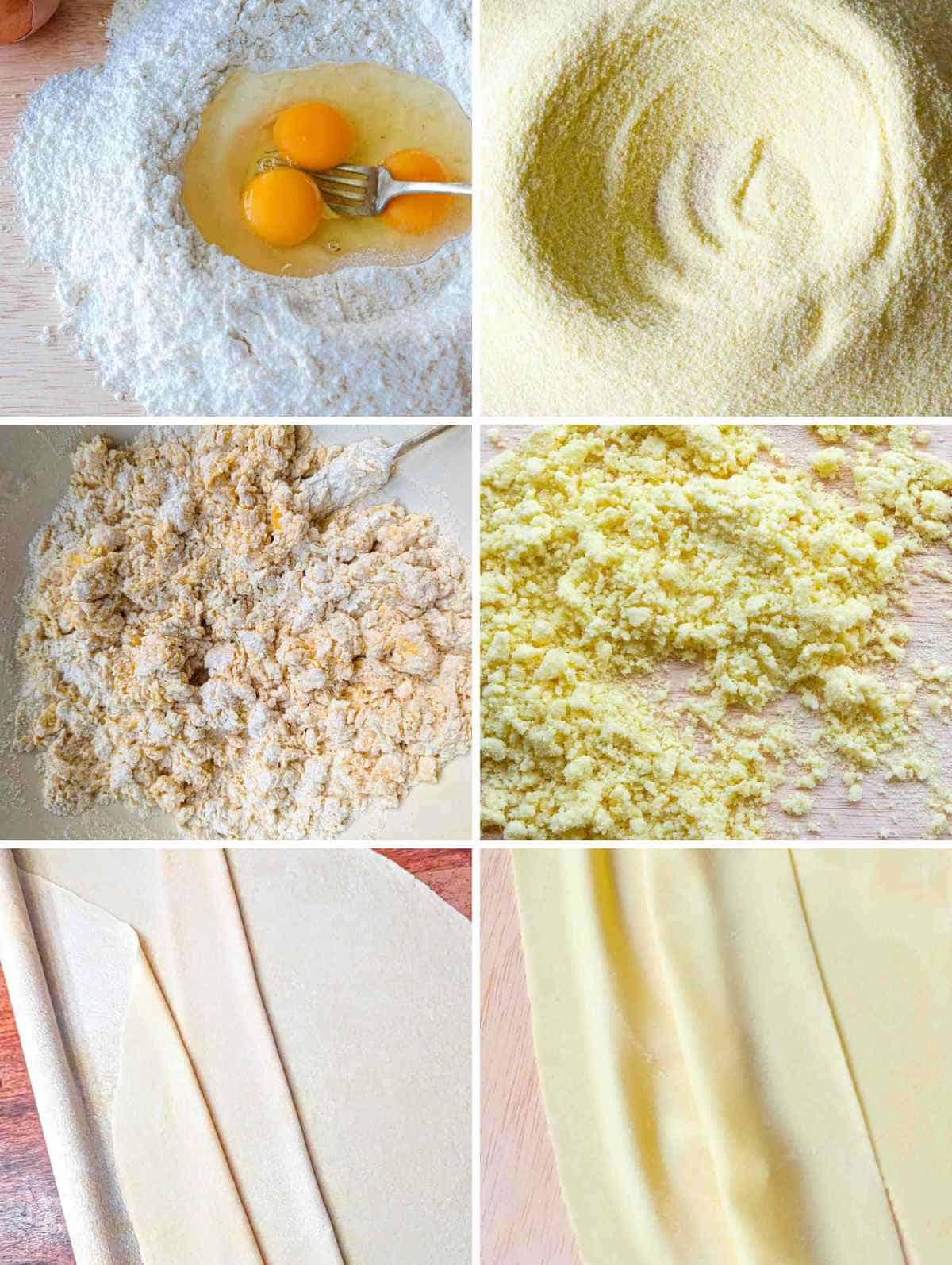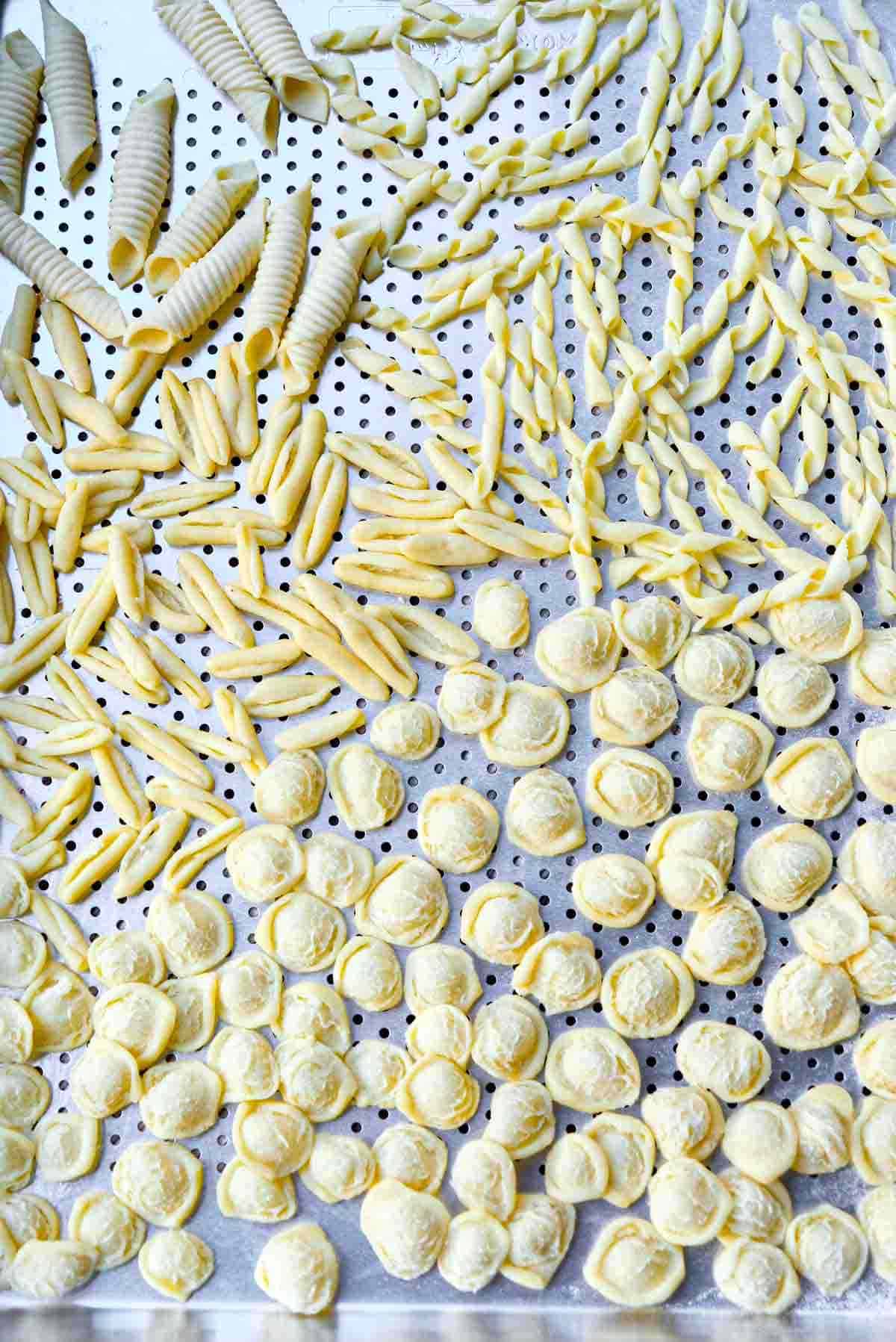If you're really deep diving into pasta making, one of the first questions you'll come to is what type of flour is best for pasta. The answer, it turns out, isn't black and white.

Good pasta starts with good flour, right? Well, yes...but actually a lot of different types of flour can make good pasta. Whether you're working with regular all purpose flour from your pantry or can get your hands on a specialty wheat flour like Italian tipo 00, beautiful pasta is within reach.
The key is getting some understanding of what properties different types of flour have so you know how to combine them to make the best pasta dough.
Quick Summary
- The best flour depends on whether you are making egg pasta or eggless pasta.
- Best flour for egg pasta dough: The best flour for pasta dough with eggs is a very finely ground flour like Italian tipo 00 (also known as double zero). The fine grind allows this flour to fully absorb the liquid egg and makes a firm but tender and pliable pasta which is ideal for long thin shapes like spaghetti, pappardelle, tagliatelle, linguini etc. as well as stuffed shapes like ravioli, agnolotti etc.
- Best flour for eggless pasta dough: The best flour for pasta dough without eggs is durum wheat (also known as semolina) which has a much higher protein content that compensates for the lack of eggs by adding structure and giving the dough more bite. This is most often used for short or rolled shapes like macaroni (maccheroni), orechiette, cavatelli etc.
- No special flour, no problem: If you don't have specialty flours like tipo 00 or semolina it's no problem - you can still make great pasta with a few adjustments as outlined in this post.
Jump to:
What makes flour better or worse for pasta?
Pasta can actually be made from a lot of different flours besides wheat flour, for example chickpea pasta or lentil pasta. For the purposes of this article, we're talking strictly wheat flours.
Even in the category of wheat flour, there are some different factors to be aware of.
Different wheat flours have different properties that can make them better or worse for different types of preparations (bread vs pasta vs cookies vs cake etc.)
For fresh homemade pasta dough, the most important factors are grind (how finely or coarsely the flour is milled) and protein content (i.e. gluten content, which is determined by the variety of wheat used to make the flour).
The table below shows the different grinds and protein content of the most common types of wheat flour.
| Flour type | Grind | Protein Content |
| Regular (all purpose) | Varies but usually medium-fine. | 8% - 11% |
| Bread flour | Medium to coarse. | 12% - 14% |
| Pizza flour | Fine to medium. | 10% - 14% |
| Cake flour | Very fine. | 5% - 8% |
| Pastry flour | Fine. | 8% - 9% |
| Tipo 00 flour | Very fine. | 10% - 12% |
| Semolina flour | Can be coarse, medium or fine. | 13% - 14% |
Traditionally there are two types of flour used for pasta making, both of which have high protein content: tipo 00 and semolina.

Tipo 00 or double zero: best flour for egg pasta
Not only is tipo 00 high in protein at 10%-12%, but this flour is also ground very finely to a texture similar to powdered sugar.
The fine grind allows it to absorb liquid and fully hydrate more which results in a more tender and pliable pasta dough.
Normally tipo 00 flour is combined with eggs in a 2:1 ratio (200 grams flour for 100 grams egg - which is approximately 2 whole eggs).
This type of dough is mostly used in northern Italy and parts of central and northern Europe. Egg pasta dough is ideal for various pasta types such as:
- Flat or ribbon shapes like spaghetti, linguini, tagliatelle, tagliolini, pappardelle, lasagna, and corzetti.
- Stuffed shapes like ravioli, tortellini, tortelloni, cappelletti, and agnolotti.
- Tubular or cylindrical shapes like macaroni (maccheroni), penne, garganelli, rigatoni, cannelloni.
- Small egg dumplings like German spatzle, Czech/Slovak halusky and Hungarian nokedli.
Egg pasta doughs are normally served with richer and more robust sauces like meat ragus but can also be served in broths or with cream or simple butter based sauces.
While tipo 00 is normally used to make pasta with egg, it can also be used to make pasta without egg.

Semolina or durum wheat: best flour for egg free pasta
Semolina flour is made from durum wheat, a type of wheat that's very high in protein (i.e. gluten) which is beneficial for pasta making since it gives the pasta a firmer texture making it easier to work with and shape.
Durum wheat semolina is an exceptionally high protein flour with somewhere between 13%-14% protein content.
This type of flour can be ground in different ways but usually is ground medium-fine for pasta making purposes.
Semolina is ideal for egg free pasta because it's made from a hard variety of wheat that gives the dough more structure than a regular flour would. This compensates for the lack of eggs.
Semolina pasta dough is a well-recognized traditional pasta mainly associated with southern Italy where it's known as pasta bianca or white pasta. Often pasta bianca is served with lighter vegetable based sauces but can also be served with cream, seafood or meat based sauces.
The typical shapes made with semolina pasta are:
- Short shapes like orechiette and cavatelli;
- Shapes associated with southern cuisine like lorighittas;
- Shapes traditionally made with a simple semolina and water dough like spaghetti (originally from Sicily and Abruzzo), pici from Tuscany, and trofie from Liguria.
The above are general guidelines based on ingredients in various traditional recipes. These aren't hard and fast rules.
Pici can be made with an egg pasta dough, and tagliatelle can be made with semolina and water only. It all depends on the cook and the recipe being made.

How does the flour interact with other ingredients in pasta?
No matter what type of flour you use for pasta, there is a basic pasta dough ratio you can always use as a reference point.
The golden ratio for pasta dough is 2 parts dry to 1 part wet.
This means 200 grams semolina to 100 grams, or 200 grams tipo 00 to 100 grams eggs (which comes out to about 2 whole eggs).
This is a general guideline, but in practice it helps to tweak it a bit to work with the properties of different types of flour and with different wet ingredients.
For a full rundown of how to tweak the pasta dough ratio to work with different types of flour you can learn more about how to make pasta dough.

FAQs
Double zero (doppio zero) or 00 is a nomenclature used predominantly in Italy that indicates how finely ground a flour is. There is also zero flour or 0 flour (less fine) and triple zero or 000 flour which is more fine.
In relation to pasta making, semolina refers to a milled flour made from a specific variety of hard wheat called durum wheat. In general, semolina as a descriptor relates to the grain milled (durum wheat) rather than the coarseness of the milling. This is a new nomenclature as it used to be the case that semolina could refer to any coarsely milled grain. For example, in some parts of the US corn grits are called corn semolina. The actual grind of durum wheat semolina (and other types of semolina) can vary from fine to coarse (in Italy finely ground durum semolina is differentiated from regular by being called rimacinata aka. re-milled or double milled.)
Semola is the Italian analogue of the English word semolina. They are both flour made from durum wheat. Semola can be found in different grinds for different purposes (i.e. for pasta or bread).
Semolina flour is good for pasta because it's a hard variety of wheat and has a high protein content. Both of these properties give more structure to pasta which provides that elusive 'al dente' quality to fresh pastas.
AP or all purpose flour has a variable protein content and grind. It can range from fine to coarse in grind, but is usually medium-fine. In terms of protein content, AP flour can be anywhere from 8% - 11% protein content. Tipo 00 flour is not only very finely ground but also has a relatively higher protein content, usually around 10% - 12%. Since tipo 00 is finer and has higher protein than AP flour, it makes a more elastic and supple pasta dough.
Yes absolutely. See how to make pasta dough for a recipe.
Pastry flour is a less desirable flour variety for pasta because it usually has less protein than regular flour. The best specialty off-the-shelf variety of flour for pasta is definitely bread flour since it has a lot of protein. If all you have is pastry flour you can still make it work, but it's ideal if you make an egg pasta dough rather than a water only dough since the eggs will provide that necessary protein and structure.
Yes salt is important since it helps to tenderize the gluten.
Yes you can absolutely make fresh pasta without eggs. The best flour option in that case is semolina ground for pasta is double milled semolina flour (in Italian semola di gran duro rimacinata).





Comments
No Comments